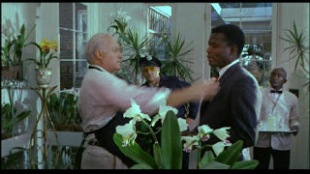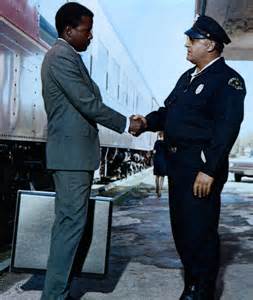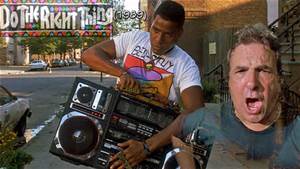Race has always been an issue in this country, especially during the time of the Civil Rights Movement, which was 1954 -1968. The first movie, ‘In the Heat of the Night’, was released at the height of these racial tensions. Since it’s release in 1967 and even today, everyone knows this movie by a particular scene about halfway through the film. It’s called “The Slap Heard ‘Round the World”. This refers to the moment where a bigoted, Southern cotton plantation owner slaps the only black male lead, Virgil Tibbs. Years of complaisant behavior by both Poitier, (Tibbs), whose usual roles include saintly role-model performances, and every African-American actor ever in Hollywood, stopped with a mighty thwack. This scene is still “brutally effective” in reminding everyone how much has changed and not changed in the last 60 years. The movie is considered both a civil rights parable and a grimy crime drama.
The movie, which is in a fictional town of Sparta, Mississippi, starts with Deputy Sam Woods patrolling his nightly route and he finds Philip Colbert, an industrialist from Chicago, murdered. In a town that shuts down around sunset, finding a witness or even a murder suspect is hard. The racist police chief, Bill Gillespie, sends Woods to search for the possible killer. Woods happens to find a black man, Virgil, sitting at the train station, alone, waiting for his train to arrive. He is automatically assumed to be the killer and gets taken to the jail. When the chief questions him, he finds out that Virgil is actually a homicide detective from Pennsylvania just visiting family. Virgil is forced by his boss to help the chief with the murder investigation. It takes Virgil clearing a few people of the murder for the chief to realize he needs Virgil’s help to solve the case. “The Slap Heard ‘Round the World” occurred due to Virgil’s idea of the plantation owner, Endicott, being a suspect. He hated the fact that Colbert was opening up a factory in town and Virgil found a piece of evidence from a plant in Endicott’s greenhouse in Colbert’s car. There is a scene where some racist locals try to stir up trouble with Virgil which forced Chief Gillespie to step in and protect him.

Virgil, being the expert in his field, asked Woods to retrace his steps the night he found Colbert’s body. He notice Woods changed his route and mentioned it with the chief riding along, which made the chief think that Woods is a suspect. Virgil eventually rules Woods out as a suspect when a girl and her brother came in claiming she is pregnant with Wood’s child. The brother is outraged that Tibbs was present during his sister’s questioning and forms a mob to get revenge. Tibbs seeks out the black woman who was paid to give the sister an abortion and she shows up for the appointment while he is still there. The mob confronts him outside and he proves to the brother that the local diner waiter is the murderer and the one who got his sister pregnant. The murderer, Henshaw, kills the brother before being disarmed by Tibbs. He confesses to killing Colbert while trying to rob him for the money for the abortion.
It takes all of the events for Gillespie to finally respect Tibbs and overcome his racism towards him. His final words to Tibbs were: “Virgil? You take care now, y’hear”. It exemplifies that, with some effort, racial divisions can be overcome.
I did some research on incidents that occurred during shooting of the film. I found out some interesting facts that are related to the racial issues surrounding the civil rights movement. Most of the scenes were shot in the south. Poitier had to take extreme measures to protect himself during his justifiably nervous stay in the South for the film. This included him sleeping with a gun under his pillow at the Dyersburg Holiday Inn during their shoot for the cotton plantation scene on location in Tennessee. This particular shoot was cut short by local thugs looking for trouble causing the production to flee back to Illinois.
In order to get United Artists to greenlight the film in 1965, producer Walter Mirisch had to crunch numbers to show that a film in which Sidney Poitier outsmarts an entire town of Southern whites could make money, even if it never played a single theater south of the Mason-Dixon line. Poitier was also worried about shooting on location in Mississippi due to his previous visit to Greenville in 1964. This visit was with Harry Belafonte to deliver $70,000 in donations to civil rights workers, but they were tailed by Klansmen and nearly run off the road.
‘Do the Right Thing’ is an American comedy-drama that was released in 1989. 10 years later, it was deemed to be ‘culturally significant’ by the U.S. Library of Congress. Spike Lee wrote, produced, and directed this film, as well as played the main character, Mookie. The movie is about one neighborhood’s simmering racial tension, which ends up in tragedy on the hottest day of the year in Brooklyn.
Mookie is a young black man living in an African-American neighborhood and works at a local pizzeria, which is owned by an Italian American named Sal. Sal’s son, Pino, ‘detests the place like a sickness’ and holds racial contempt for the neighborhood blacks. He attempts to make Mookie’s life miserable. A few arguments being in the neighborhood, the first one between Sal and a black man called ‘Buggin’ Out’. They are arguing about Sal’s wall of fame only having pictures of Italians and no black famous people even though his pizzeria is in a black neighborhood and all of his customers are black. Mookie and Pino are arguing about which race is better, Italian or black, which leads to a series of scenes where the characters spew a variety of racial insults.
Buggin’ Out convinces 2 others, Radio Raheem, who carries a boombox that constantly plays ‘Fight the Power’ by Public Enemy on full blast, and Smiley, to join his protest about the wall. Later that night, they all enter Sal’s pizzeria after hours to demand he change the pictures. Sal gets mad and snaps after they argue about Radio’s boombox being too loud and threatening each other. In his fit of anger and frustration, he calls Raheem the “N” word, (I refuse to say the entire word even though it’s in the script), and destroys the boombox. As the fight escalates and moves out into the street, a crowd gathers. Raheem is strangling Sal as the police show up to break up the fight. While they are trying to apprehend Raheem and Buggin’ Out, one of the officers puts Raheem in a chokehold, which inadvertently kills him and Buggin’ Out is cuffed and put in the back of a cruiser, beating him with a stick in the process. When the cops realize they had just killed a black man in a black neighborhood with an angry crowd watching, they put his body in the back of another car and take off. This left Sal and his sons alone with the angry mod, which blames Sal for Raheem’s death. The mod contemplates violence against them, but Mookie redirects their violence to the pizzeria by throwing a trash can through the window and yells ‘hate’. The building is lit on fire and as Raheem’s boombox, in flames, plays ‘Fight the Power’, Smiley hangs a picture of Malcolm X and Martin Luther King Jr. on what is left of Sal’s Wall of Fame.
The film ends with 2 quotes: One from Martin Luther King Jr. that describes violence as an immoral strategy that destroys society and the other from Malcolm X that describes violence as a sign of intelligence when used in self-defense, before fading into a picture of them shaking hands.
According to Wikipedia, the film was released to protests from many reviewers, and it was openly stated in several newspapers that the film could incite black audiences to riot. Lee criticized white reviewers for implying that black audiences were incapable of restraining themselves while watching a fictional motion picture.
One of many questions at the end of the film is whether Mookie “does the right thing” when he throws the garbage can through the window, thus inciting the riot that destroys Sal’s pizzeria. Critics have seen Mookie’s action both as an action that saves Sal’s life, by redirecting the crowd’s anger away from Sal to his property, and as an “irresponsible encouragement to enact violence”. The question is directly raised by the contradictory quotations that end the film, one advocating nonviolence, the other advocating violent self-defense in response to oppression.
Spike Lee has remarked that he himself has only ever been asked by white viewers whether Mookie did the right thing; black viewers do not ask the question. Lee believes the key point is that Mookie was angry at the death of Radio Raheem, and that viewers who question the riot’s justification are implicitly failing to see the difference between property and the life of a black man.


